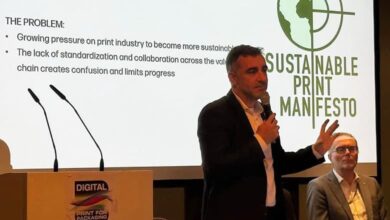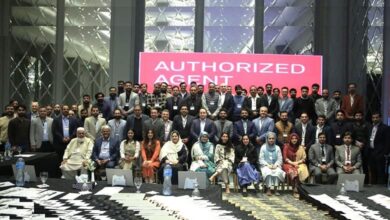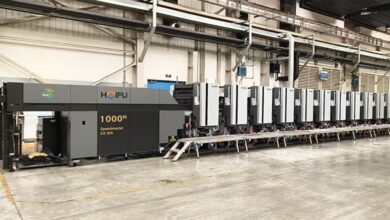
A line-up of high-profile speakers from across the label and package printing industry are set to take part in the Label Congress 2021 educational program that will run alongside the main exhibition on the first two days of the show. It is the first live event of its kind to take place this year in North America.
The program includes a two-day topical conference offering a mix of 10 presentation and panel-led sessions taking place on 29 and 30 September. A Label Academy-led technical master class also takes place on the third day of the show.
Day one of the conference focuses on global market trends and key technologies. Among the session highlights is the opening joint presentation providing a global market view, led by TLMI president Linnea Keen and AWA president Corey Reardon. Other day one highlights include Filip Weymans, VP global marketing, Flint Group Digital/Xeikon, and AB Graphic International’s west coast regional sales manager Jim Kehring, who will present on digital embellishment technology. Other session topics include: a panel discussion examining whether converters should diversify into flexible packaging, with panelists including Matt Bennett, global VP, packaging strategy, Fujifilm; and a further panel discussion looking at the benefits of hybrid printing. Avery Dennison will also present on how to get smarter with the Internet of Things. Participating converters include Mark Wegmann, owner of Wegmann Companies, AWT and Premier Markings.
Day two is themed around future-proofing your business. Highlights include the opening session on data transparency, led by Federico D’Annunzio, founder of transpar3nt.com and winner of the 2020 Label Industry Global Award’s global achievement honor. Mike Rottenborn, CEO, Global Graphics, Geert Van Damme, managing director, Cerm, and Robert Buongiorno, president, BST North America, are among the panelists at a later discussion on how far industry 4.0 and automation can go; while sustainability is the topic of another panel discussion featuring Julian Cass, VP North America NW, Flint Group, Kevin Clunie, VP sales & marketing / CELAB VP, Mactac, and Abby Meyer, research engineer, Belmark. Other topics to be debated include creating a culture of continuous improvement and how to recruit / retain young talent.
Additionally, the in-depth master class hosted by the Label Academy on 1 October will cover self-adhesive label materials. Delegates will gain a technical understanding of the nature and construction of self-adhesive laminates, how they are made, the importance of materials and the need for different adhesives. They will also learn why different laminate constructions are needed, their usage, how to identify them, and different self-adhesive testing procedures. Presenters include Cynthia Frost White, president and CEO, Channeled Resources Group, who will provide an overview of release liner substrates (papers and films), and Melissa David, product line manager – packaging division, FLEXcon, who will cover identification and characteristics of self-adhesive materials. Avery Dennison will present on paper and synthetic paper face materials, while 3M will guide attendees through some of the adhesive systems and substrates.
All conference sessions will be made available on-demand the day after they take place. Tasha Ventimiglia, Label Congress 2021 event director, commented: “We are very much looking forward to bringing the industry back together at the only event of its kind this year in North America. Industry learning is an ongoing process, so we are delighted to be able to offer an on-site opportunity for attendees to continue this as we move into the post-pandemic recovery phase, with a high caliber of speakers tackling the industry’s most pressing topics. What’s more, by also making this content available on-demand digitally, we can offer this learning opportunity to a wider global audience that is unable to attend in person.”
Echoing this, Corey Reardon said: “I am looking forward to participating in one of the first in-person industry gatherings since the start of the pandemic, and am also looking forward to supporting this event by providing insights, alongside Linnea Keen of TLMI, on the labeling and product decoration market. Together, Linnea and myself will set the stage for this premier labeling event, creating an interactive “offline” exchange of information, thoughts and insights, reflecting the challenges and opportunities in a post COVID-19 label industry.”
Mike Rottenborn added: “Innovation is especially strong in the labels and packaging market so we are pleased to join the panel discussion on automation which is the next logical step for this dynamic sector to take. Digital presses need to be smarter to take their place in the smart print factory, and greater automation will not only bring greater productivity to production lines but provide the ability to collect detailed data from an individual press and share with the wider enterprise.”
Matt Bennett said: “Digital packaging, especially in flexible packaging, is still in its infancy, however is forecasted for robust growth. This creates a huge market opportunity for label converters looking to move into high-growth areas like flexible packaging. I’m happy to share my outlook and business potential on how a label converter can leverage this opportunity.”
Ventimiglia added: “Places are limited for all conference and master class sessions, so attendees are strongly encouraged to book as soon as possible.”
Label Congress 2021 takes place from 29 September to 1 October at the Donald E. Stephens Convention Center, Rosemont, Illinois.
For the full program and booking details for either the conference or master class, visit: www.labelexpo.com/congress/conference-program or www.labelexpo.com/congress/self-adhesive-label-materials-master-class.






143 Comments